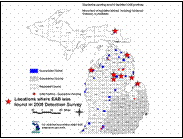




Acknowledgements:
We would like to thank the USDA Forest Service for funding this
work. In addition we would like to thank all of the park managers who allowed us to
work in their parks as well as the EAB surveyors (Bernie Huetter, Steve Takac, Keith Martell, Jr., Pete Davis, Keith
Martell III, and Heather Johnson), Molly Cypher, Eric Van Wormer and Robert Benson.
ABSTRACT
In July 2002, wood-boring beetles
collected from ash trees in southeastern Michigan were identified as Agrilus planipennis (Emerald Ash Borer (EAB)). This beetle is capable of killing black,
green and white ash of all sizes, including trees that are apparently
vigorous. Efforts to reduce the spread
of this insect, and to eliminate small, local populations are dependent on
early detection of the presence of EAB in an area. Detection surveys by Michigan Technological
University (in collaboration with the Michigan Department of Natural Resources
and the USDA Forest Service) were conducted in 2004 and 2005 in an attempt to
detect EAB in areas at high risk for introduction through the movement of
firewood and where populations of EAB would be at levels too low for detection
by visual observation of damaged trees.
These detection efforts utilized trap tree methodology as well as
firewood surveys. A total of over 170
sites were surveyed in Michigan (2004-2005) and Northern Wisconsin
(2005). In 2004 EAB was found in
firewood at three sites in Lower Michigan.
In 2005 EAB was detected at eight sites in Michigan through a variety
of survey methods. One of these sites was the first record of EAB in the Upper
Peninsula of Michigan. EAB was not
detected at any of the Wisconsin sites
In addition to the survey, experiments were conducted in southeastern
Michigan in 2005 in an attempt to further refine current trapping
methods. The effect of girdling on
tree health as well as landing behavior of EAB was examined.
Results from 2005 trapping experiments





Detection of Emerald
Ash Borer (Agrilus
planipennis Fairmaire)
in Michigan and
Northern Wisconsin
Jessica
A. Metzger, Andrew J. Storer, and
Michael D. Hyslop
School of Forest
Resources and Environmental Science, Michigan Technological University,
Houghton, MI 49931



•117
sites were surveyed in 2004
•Expanded
to 173 sites in 2005 including N. Wisconsin (Fig. 1)
•Sites
were located in campgrounds and parks considered at high risk for EAB due to the movement
of firewood and presence
of a significant ash resource
•5-7
trap trees per site in each year
•Trap
trees were girdled in April and a sticky band placed above the girdle (Fig. 1)
•Traps
were monitored every two weeks from May through August for adult EAB (Fig. 2)
•Tree
health measurements including vigor, dieback, and light exposure were recorded in July and
September.
•A
subset of trap trees were cut and peeled in September/October to look for larvae
(Fig. 1, 2). Remaining trap trees will be used in 2006.
•Firewood
inspections and visual surveys of declining ash trees were conducted as time allowed
Firewood
Survey Results



Lower
left: Trap tree cut and peeled to look for larvae under bark

•In
2004 EAB was found in firewood at three campgrounds in Lower Michigan.
•Two
of the three sites where EAB was found in firewood in 2004 had active EAB infestations in
2005
•In
2005, EAB was found at eight sites, seven in Lower Michigan and one in the Upper Peninsula (Fig.
3). Of these eight sites, five were on trap trees, one was found
peeling bark, one was in a firewood pile and one was found through visual surveys of declining ash.
Figure 3: 2005 Detection Survey
Results
Emerald ash borer was found at eight
new locations

•Firewood piles were surveyed as time
allowed
•Surveyors
recorded the firewood pile size, whether it contained hardwood, and presence and % of
ash.
•In
2004, a preliminary survey was conducted and 1846 firewood piles were inspected. Eight percent of the these contained ash wood and EAB was found in firewood at
three sites.
•In
2005, inspections were expanded and 5649 piles were inspected (Fig. 4). EAB was found in firewood at one location.

Figure 4: 2005 Firewood pile survey results by site
type

Survey Methods

•In
2005, a series of trapping experiments were conducted in Southeast Michigan where EAB populations are
established
•We
examined the effect of girdling on trap catch as well as the potential for using girdled trees for
multiple years of trapping
•In
addition we looked at landing behavior of EAB and attraction of EAB to different colored traps
• In the landing behavior experiment (Fig.
5) 913 EAB were captured on sticky bands. Ninety three percent of
these were caught on ash trees. This demonstrates a clear preference
for landing on ash.
•In
our girdling experiments we caught significantly more EAB on older girdled trees (Fig. 6)
•In
our colored trap experiments a significantly higher number of EAB were caught on purple traps (Fig. 5)
than on yellow, pink or clear.
•Additional
experiments will be done in 2006 to attempt to further refine trapping methods for EAB


Figure 5
Above left: Landing
behavior experiment,
sticky bands placed on all trees (regardless of species) in ½ acre plot
Above right: Purple sticky trap

A
B
B
Preliminary analysis:
ANOVA followed by LSD
multiple comarpison test
Figure 6:
EAB caught on trap trees
in southeast MI,
Summer 2005

Detection Survey Results